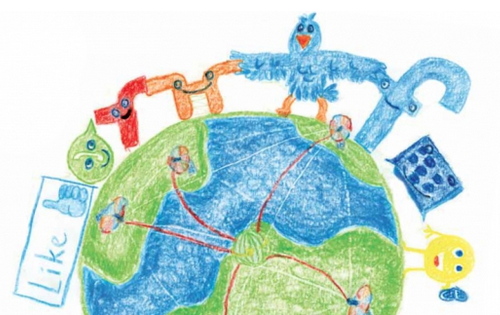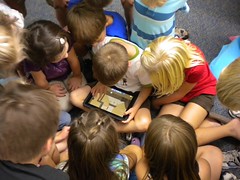
Social Media at Elementary School
This week I received the book ‘Social Media at the Elementary School’ in my inbox, from Remco Pijpers. The book is in Dutch (Sociale Media op de Basisschool), and my immediate thought was: ‘Why is there no such book in English?’ Are people not thinking about social media in elementary schools? Are social media ideas at elementary schools in the US spread in a different way? Or are schools in the Netherlands leading social media implementation at elementary schools? I would love to hear ideas where social media is being used at elementary schools across the world. I am sure there are ideas out there that need to be spread regarding social media use at elementary schools.
The ideas in the book are very inspiring, and I look forward to hearing my kids come home with stories about social media use in their classrooms. The book is available to download for free (in Dutch). Most of our blog’s audience does not understand Dutch, I am sharing with you an overview of the 21 ideas presented in the book. Next to the ideas presented in the book, it also contains a plan to implement social media at your elementary school.
#1. Run a Travel Agency on Twitter
The first idea is a great one, Tessa van Zadelhoff, a 5th and 6th grade teacher started travel agency ‘Beartravel‘. The class receives request through Twitter to plan a trip for a client, and the students are researching how to get there and where to stay; they even make a financial analysis for the clients and send it to the client. Tessa Zadelhoff won an award for innovative teachers in Washington DC. The students also make a presentation about the city where the client wants to travel to. The video is presented with Google Street view on a digital board in the classroom, so the kids can be a tour guide in any city around the world. The students also make brochures and simple language guides for their clients.
#2. Raise money for a non-profit with Social Media
The 2nd idea is from sixth-grade teacher Nadine Duymaer van Twist and Esther Windhorst. This class use social media to raise money to buy solar led lights for kids in Kenya. The class raised funds by connecting with people through Hyves (a Dutch social media site), Twitter, the school website and also through calls and text messages to support the goal. Normally kids are not allowed to use their phone at school, but for fundraising they were allowed to use their phone.
#3. Set up a wiki for your class
Elke Das teaches 3rd and 6th grades and she started a wiki for class where she posts the activities for the week, reminders, prepars for tests, mind maps, etc. it also offers a chat for kids to communicate. Kids post writing assignments and other kids offer their feedback in the comments.
#4 Use QR codes in the classroom
QR codes are quick response codes, they are barcodes that provide information. Linda Humme uses QR codes in her classroom to store answers to math problems, pictures and movies. It cost the students more effort to find the answers, and therefore the students remembers the answers better. Students that need explanations, can scan the appropriate QR code and watch the YouTube movie of the teacher explaining the material.
#5. Set up a blog for your class
Hilde Vosselmans started a blog for her 3rd grade class. Most of the information on the blog is written by her, but she motivates her students to write stories and notes on the blog. When her students write a blog post, she gives them a “no–homework” coupon for contributing to the blog.

#6. Use iPods in the class room
Picture by flickingerbrad
In society, tablets and smart phones are a common good. There are so many apps available and many with an educational benefit. Gerko Warner, teaches 4th, 5th and 6th grade, and uses apps to improve kids’ learning. If you compare the costs of software to the cost of apps, it is such a money saver for school; Software could easily cost $500, and apps are available for $2.
#7. Involve parents on Facebook
Many of your kids’ parents are on Facebook. If you want to increase communication with parents, why not communicate with them on the platform that they are most used to: Facebook. Facebook is a great platform to post class pictures, invite parents to join on field trips, share relevant information to help the teacher or the classroom.
#8. Create a videoclip with the class
Sanne Kuyt created with her 5th grade class a lip dub. A lip dub is a type of video that combines lip synching and audio dubbing to make a music video. He worked 3 full days with his class and created a YouTube video that got more than 50,000 views. He asked people on Twitter with lots of followers to retweet the video and then it went viral.
#9. Keep sick kids involved in the class room
Too sick to go to school, doesn’t have to be an excuse anymore. Miranda van der Veer had a 1st grade student in her class, that was not able to go to school for months. They had set up a laptop with WebCam, so the class could interact with her and she could see what happened in the classroom.
#10. Mind maps and 3-D playground design
Roel Spits is the school principal; when the school was planning for a new playground, he involved the students in creating designs of the playground in clay. With a 3-D scanner they scanned the clay and projected it on Google earth, so they could see how it would look in real life. Also his school uses mind maps in the upper grade classes, for example for a presentation or to create a portfolio.
#11. How to use Twitter in the classroom
Maarten Hendriks uses one Twitter account for his 5th and 6th grade class, and shares math or history challenges on Twitter. Kids like the Twitter challenges better than homework. His students are also able to write on his Twitter account, by using the format @meesklas|studentname. They basically all tweet on the same account to the same account.
#12. Use E-tools in the classroom
If you need to make a graph, why should you make it on paper; that’s what Erwin Klaasse thinks, who teaches 5th and 6th grade. He uses e-tools especially in history lessons and since he started using it, the test results became extremely good. Students also collect and present their ideas on a Tumblr blog, that is protected with a password.
#13. Get to know your class mates better with video
Timon Bos, who teaches 3rd grade, had a child in his class who got bullied. Nobody wanted to have a playdate with him at his house. His parents offered to make a video of him at home, and to share it in the class. After showing the video, kids wanted to come over and play with him. When Timon saw the effect the video had on this boy, he offered other kids the opportunity to create a video about themselves as well.
#14. Interact with your student on Hyves
Hyves is a Dutch social network. Teacher Koert Verdouw who teaches 4th and 5th grade, shares about his personal life a protected area on Hyves. Kids can read what the teacher shares, and kids can share what they are doing in their spare time. Koert speaks with the class on how they should interact with each other online: don’t fight, what kind of pictures to post and saying nice things.
#15. Share stories wit podcasts
Mandy de Bruijn teaches 3rd and 5th grade and her students record ‘radio-show’ podcasts. Instead of writing for language arts, music or science, they now record and tell the story. The 5th graders usually help the 3rd graders with editing the podcasts. When someone finishes a podcast, the whole class will listen to the podcast.
#16. Collaborate with kids around the world
A Learning Circle is a temporary learning community in which kids and teachers from different countries around the world collaborate and learn together through social media. The students learn together about the same topic, like ‘our life and our country’ or ‘sports and hobbies’. Every groep (class in each country) asks a question and the other students are going to research that question and answer it as well as they can with text, pictures, video and presentations. Kids communicate with eachother through a wiki and other social media.
#17. One week no media use
To get students better understand how much we use media and how it is engrained in our lifestyle, teacher Peter de Vos implemented a week that kids were not able to use any media. This was a voluntary decision by the students, but obviously not an easy one. And Peter got the parents of the kids involved to come up with a plan of alternative activities that the kids could do in the week without media use. It is great for kids to understand how different their week looks like without media use. Parents had planned activities as soccer tournaments, cake baking and to bring a visit to a tv studio.
#18. Engage colleagues to use Social Media in their class room
Instead of being the IT coordinator at school, that fixes the computers when broken, Frank Jongbloed, who teaches 5th and 6th grade, has become the IT innovator at school. He motivates his colleagues to use different kinds of social media in the class room. Frank researches the web for applications that are of benefit to his teachers and presents those tools to them, and also works with them on how to integrate it in the class room. Examples like Tumbler for a blog, or youtube video’s and lyrics to have students practice their English.
#19. Share your knowledge online for teachers around the country
Marcel Schmeier shares tips, resources and other blogs on his blog onderwijsgek.nl (in Dutch). By sharing his ideas online he can help classes around the country, and at the same time other teachers can share their best practices to improve class rooms all across the country. He shares reviews of different teaching methods. What started as a site to help him organize his findings about education, now help many teachers around the country and they contribute to the blog as well.
#20. Show off your school on Facebook
Bernadette de Schepper is de school principal and she set up a Facebook page for her school for PR purposes. Parents, friends, grandparents and nearby residents have friended the school, and since then the small school has grown with 10% more students. They share news on Facebook and especially shares about events and post pictures and updates about the daily going-ons at school.
#21. Use LinkedIn to increase sharing of ideas
Mark Leek hosts a LinkedIn group where 200 members who work in Special Education are communicating with each other to share knowledge, tips & tricks. Where these people used to meet each other only at conferences, they now have an online forum where they can meet and chat with each other to support and improve their communication. Mark personally reaches out to people that can contribute to the group. When you start a group on LinkedIn: be patient, and actively engage people in your group to respond.
